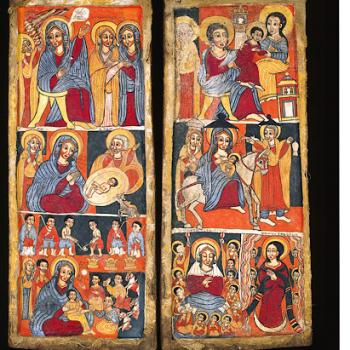
My Dad was plain: “No mythic fat man is getting the credit for the presents I get you.” He was pro-imagination, but totally opposed to lies: better to die than to tell a lie. So we learned the truth about Santa and enjoyed the stories and images, though most were no older than Coke marketing. As legends, they were not much since even Kris Kringle animated by the genius of Rankin and Bass paled next to Arthur, Middle Earth, or Narnia.
Dad told us the truth about Santa, not a lie. However, it would have been a different sort of lie to say Santa did not exist in one sense.
Don’t get me wrong: Santa has never been believed to exist like Plato, or Jesus, or us. However, it is not quite right to say that Santa has no share in existence.
After all, there was a real Saint Nicholas and he did love and help children. We learned early on that even the most foolish marketing ploy is often spun from a real tale.
However badly, Santa Claus points back to a person just as real as Socrates and just as important.
It wasn’t long until Mom and Dad, watching that ancient—now dead—event, the Evening News (Walter Cronkite!), taught us that even the “news” was a way of telling a story. Even if the facts were all true, newscasters were telling a particular tale.
This did not mean we could ignore the facts or pretend that what we wished was so. God forbid! Whatever meaning we gave to “just the facts” (Dragnet was a family habit) had to fit the facts, but we learned that there could be more than one way of doing this… my Mom was ahead of Quine!
Fiction can tell truths about the world while making up some facts.
What about fiction (like stories of Santa)? There is no Aragorn son of Arathorn and he was never king in Gondor, but Lord of the Rings contains important truths we can learn. Middle Earth is not a lie, just a fiction. The fictional world of Middle Earth is real in a subsidiary sense to God’s world. Middle Earth is meaningful where it was good, true, and beautiful. When Samwise is brave and endures in faithful service, the fictional character is pulling in ideas so real that he gains a shadowy existence of his own.
Some hyper-fundamentalists, both atheist and Christian, have a disdain for fiction because they just want reality. They are right to want reality, but wrong to limit themselves to only one kind of reality.
Atheists reject the metaphysical hard reality of God, but we Christians shouldn’t gloat. There are Christian fundamentalists who, if they learned that Job was (in theory) just a Hebrew drama, would feel that it was a lie. This is absurd.
How I taught my kids about Santa
When my kids asked if Santa existed, I said: “No, not if you mean like God, your Mom, numbers, or ideas, but yes if you mean as a fictional character.”
Of course, there are forms of Santa, some truer than other forms. L. Frank Baum created Oz and imported Santa into that world, but his Santa was one dimensional: all presents, no personality. The classic Coke illustrations are better, giving him more depth.
Perhaps, the best you can say of Santa is that he is in deeper shadows than Sherlock Holmes, not nearly as real as Reepicheep, but doing some good work in our culture. When Santa is an encouragement to good works, then he is most alive: Miracle on 34th Street is almost right. When Santa sells cars, he fades…
No, Virginia, there is no Santa Claus as you conceive him, but there are some Santas out there in the shadowland of imagination. Appreciate what you can.
Rachel Motte edited this essay.











